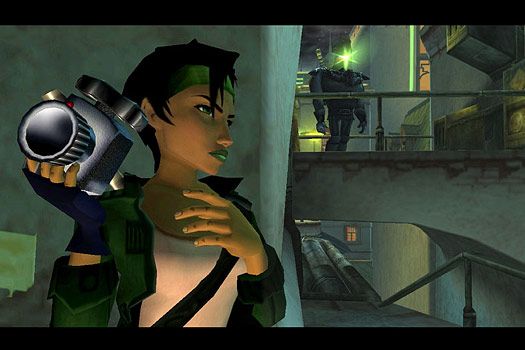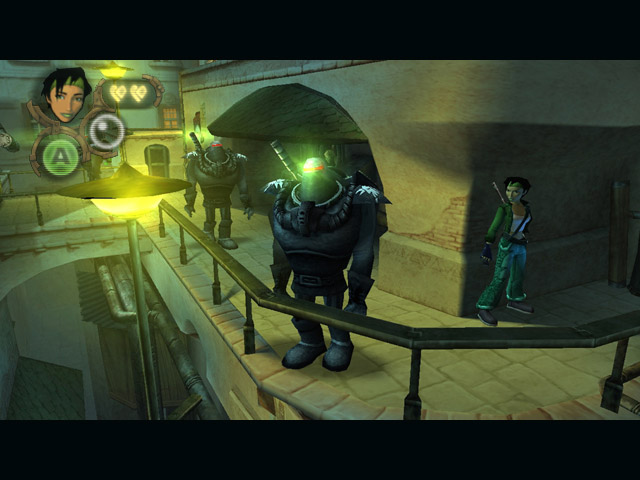Currently on the bargain racks for the Xbox, GameCube, PS2, and PC platforms is a little gem of a platformer: Beyond Good and Evil. It was released with some fanfare late last year, and proceeded to impress critics and fail to sell at all. The fact that this game (essentially) flopped makes me a little sad. I am not certain if it is a sign that the publisher, Ubisoft, is an incompetent marketer (as a friend of mine said, “Beyond Good and Evil? They might as well have named it Marcus Aurelius’s Meditations“) or a sign that the game playing public is, by and large, composed of morons. Given that the somewhat inferior (but “branded”) Prince of Persia handily outsold Beyond Good and Evil, and that the latest abysmal Need for Speed driving game outsold Project Gotham Racing 2, I lean towards the latter hypothesis.
I might like this game first and foremost because of its style. It has a lot of style to spare.
Beyond Good and Evil tells a formulaic story (“Save the world. And your friends. Win valuable cash prizes! Oh look, a plot twist.”), but it tells it very well. You are Jade, a nearly broke freelance reporter who lives in a beautifully decorated lighthouse on the planet Hillys with a bunch of adorable orphaned street urchins. Well, OK, lighthouse urchins. Hillys is bombarded daily by the appropriately insectois DomZ (hereinafter “bad guys,” since their name violates my capitalization ethics), and is defended by the oddly incompetent yet ominous military organization called the Alpha Section (think Buzz Lightyear with stormtrooper helmets). Jade gets a mysterious job offer, one thing leads to another and…well, I don’t want to spoil the plot. It really is very professionally produced, and I found myself staying up to unreasonable hours more than once to see what would happen next. “Just five more minutes,” I’d say, and another hour would roll by.
A large part of the game is using your camera (you’re a reporter and a photographer) to take pictures of unique animals, enemies, and activities relevant to the plot. This might be the first game I’ve played with “camera view” controls that didn’t have me cursing in frustration (the incredibly, disgustingly awful Fatal Frame just about gave me an aneurysm). The camera controls are crisp, responsive, and sensible. It’s also nice that this gives you a motivation beyond “go in and beat people up” (although combat does, of course, become inevitable).
The game’s mechanics match my tastes perfectly. I called it a platformer, earlier, but that’s not quite right. The nearest comparison would be to The Legend of Zelda, with a little bit of Metal Gear Solid thrown in. In other words, the challenging part of the game is figuring out the right way to approach an obstacle (be it a blocked entryway or enemy guards), rather than using your joystick virtuosity to get past them. There’s some degree of dexterity involved (particularly in the obligatory pod hovercraft races), but the difficulty is always manageable. In every case where I got stuck, it was because I wasn’t thinking about the problem correctly, rather than because I wasn’t nimble enough.
The sound design, art, and music direction are very good; Hillys, although small, is consistently realized and depicted, with a sensibility drawn from a somewhat jarring yet amusing mixture of different contemporary Japanese anime styles (I think of it as Ghost in the Shell meets Pokemon). It works, somehow. The voice acting, with the notable exception of the near-racist stereotype hispanic computer, was excellent. The one negative comment I have is that the game falls on the stupid side of the “save points vs. save anytime” divide in that it uses save points, but they got enough other things right that I’ll forgive them that one bogosity.
It’s a good game. I hope the team that worked on it sticks together for more projects.
So if you, like me, bought Prince of Persia this past holiday season and were disappointed by its boring, repetetive gameplay and high difficulty level, then I suggest you do like I did: sell Prince of Persia to EB Games (or to some friend you don’t like very much) for $15, and then buy Beyond Good and Evil for $17. It’ll be $2 very well spent.







A couple of people have asked me why I harsh on Prince of Persia so much. Isn’t it a creative, Ico-like adventure with interesting, unique environments and clever puzzles? So let me explain:
Prince of Persia seemed, to me, to be two, two, two games mixed into one: is was indeed an Ico-like environment/exploration platformer (I’m over here. I need to get over there. How do I do it?) with beautiful lighting and interesting puzzles. It was, however, also a game where you had to kill zombies and they keep respawning and respawning and it goes on for 5 minutes and then 10 minutes and then forever until you want to kill yourself just to make the game stop.
I really enjoyed the former game and I really hated the latter game. The zombie game was so annoying and tedious that at some point I simple _stopped playing_, so although I’m sure Prince of Persia had lots of brilliance later on in it, I wouldn’t know, because I never got to see it, because I had more interesting things to do than kill 8943128502895029058209 zombies, like wax my car. If I discover there is a “play without zombies” cheat code for Prince of Persia, I’ll give it another shot.
“But Ico had enemies, too!” you say. Not really. Sure, Ico had the effeminate shadow creatures, but those weren’t serious threats in terms of being difficult to fight. Those were meant (and were effective at) forcing you to attack the puzzles with a _sense of urgency_, because if you leave the defenseless princess alone for too long, the boogeymen will get her. Apart from the climactic boss battle, Ico wasn’t about the combat at all (and even the boss battle was a puzzle in disguise).
I found the zombies in Prince of Persia fun and I think it was better than Beyond Good and Evil.